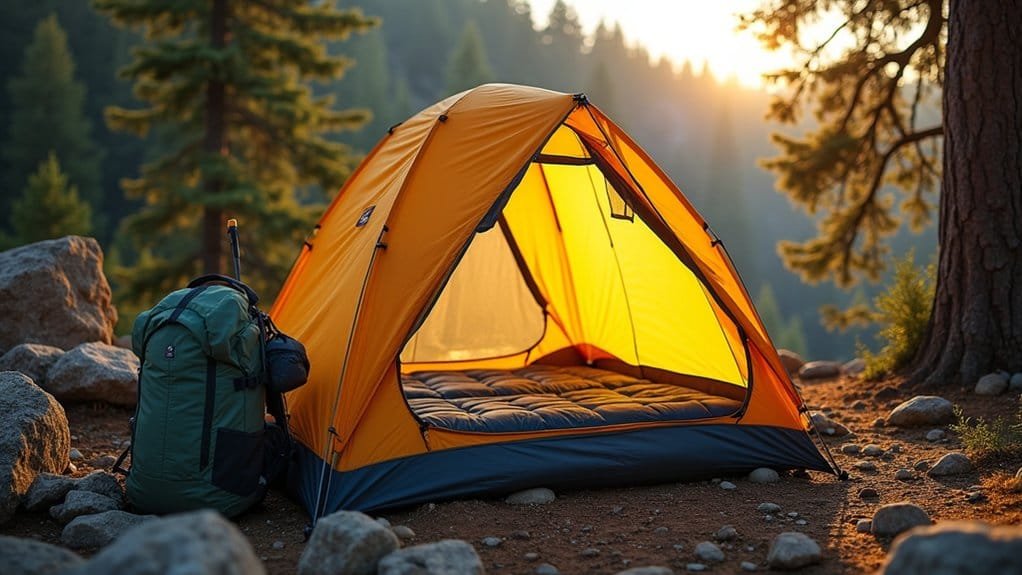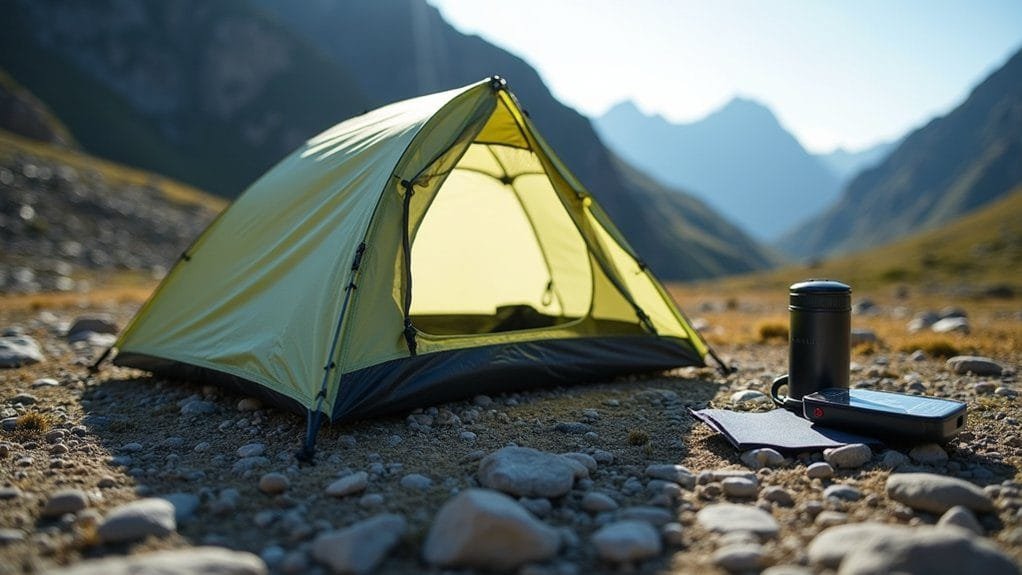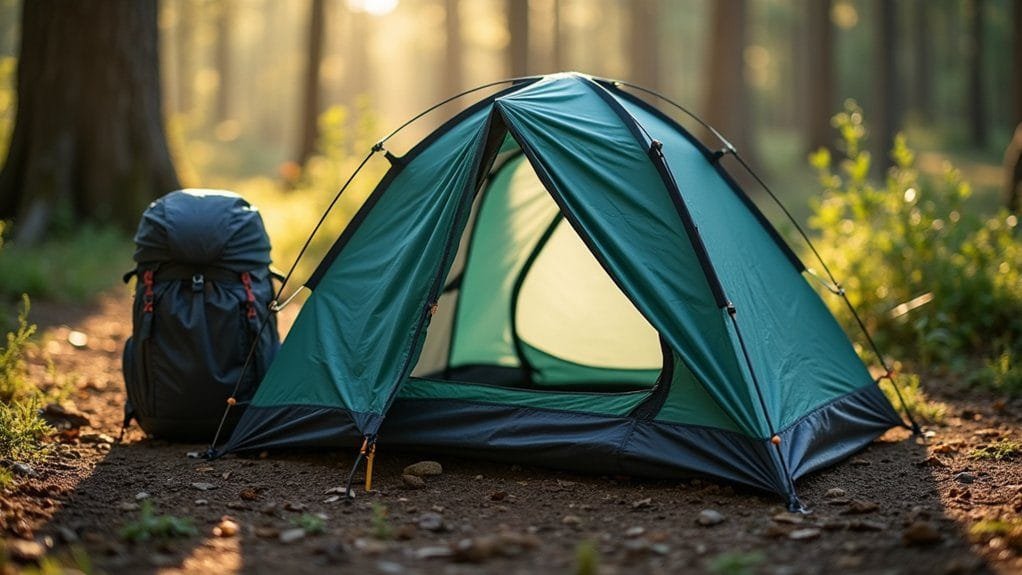When choosing a backpacking tent, you’ll want to prioritize weight, capacity, and seasonality. Opt for a two-person tent to accommodate gear, focusing on ultralight designs under 2 pounds. Consider 3-season versatility for most conditions, evaluating peak height, multiple doors, and smart ventilation. Balance fabric durability with weight constraints, and match the tent to your adventure style. Your perfect shelter awaits deeper exploration.
Key Takeaways
- Assess tent capacity based on the number of users, considering extra space for gear storage and comfort during multi-day backpacking trips.
- Select appropriate seasonality (3-season or 4-season) depending on expected environmental conditions and terrain, balancing weight, durability, and weather protection.
- Prioritize lightweight design with ultralight materials, targeting a minimum trail weight around 2 pounds for easier backpacking and reduced physical strain.
- Evaluate moisture prevention features like smart ventilation systems, double-wall construction, and precision seam taping to ensure internal comfort and dryness.
- Consider budget constraints while matching tent features to your specific backpacking needs, balancing performance, durability, and cost-effectiveness across different price ranges.
Understanding Tent Capacity and Livability


When choosing a backpacking tent, understanding capacity and livability is crucial for a comfortable outdoor experience. Most backpackers opt for two-person tents, which offer an ideal balance between weight and interior space. Consider upsizing by one person to accommodate gear and guarantee comfort during shared camping trips. Evaluate livability factors like peak height and floor dimensions, as vertical-walled tents provide more usable space compared to tapered designs.
Multiple doors enhance accessibility, allowing occupants to enter and exit without disturbing others. Peak height and interior storage options directly impact your tent’s comfort level. When evaluating tent capacity, prioritize interior space and practicality. In-store setup testing can reveal critical insights about headroom and overall livability, helping you make an informed purchasing decision that meets your backpacking needs.
Evaluating Tent Seasonality
Because seasonal versatility directly impacts tent performance, understanding tent classification becomes critical for backpackers planning diverse outdoor adventures. 3-season tents offer maximum versatility for spring, summer, and early fall, providing lightweight weather protection with excellent ventilation and bug screening. These ultralight tents balance performance and weight, making them ideal for most backpacking trips.
Conversely, 4-season tents are engineered for extreme conditions, featuring robust construction to withstand snow loads and high winds during winter expeditions and high-altitude challenges. While heavier and less breathable, they’re essential for mountaineering and winter camping scenarios. Your choice depends on planned trip environments: lightweight 3-season tents suit moderate conditions, while 4-season models guarantee protection in harsh, unpredictable alpine environments.
Analyzing Tent Weight and Materials


Although backpacking demands strategic gear selection, tent weight and materials represent critical decision points for outdoor enthusiasts. Your tent’s denier rating and fabric composition directly impact durability and performance. Ultralight tents weighing around 2 pounds offer significant pack weight reduction compared to budget models at 4-5 pounds, but you’ll need to balance minimalism with structural integrity. Consider minimum trail weight versus packaged weight to understand the complete gear profile. High-strength aluminum poles from manufacturers like DAC provide essential structural support without compromising weight efficiency. When evaluating tent fabrics, prioritize materials with appropriate denier ratings (40D-70D for floors) that withstand trail conditions. Remember that ultralight designs might sacrifice interior space and long-term durability, so choose wisely based on your specific backpacking requirements.
Exploring Minimalist Shelter Options
For backpackers seeking ultra-lightweight shelter solutions, minimalist options present compelling alternatives to traditional tent designs. Tarp tents and bivy sacks offer lightweight options that dramatically reduce pack weight while maintaining basic protection from the elements.
| Shelter Type | Key Features |
|---|---|
| Tarp Tents | Built-in floor, bug netting |
| Hammock Tents | Elevated sleeping, rainfly protection |
| Ultralight Configs | Fly/footprint, trekking pole support |
Experienced backpackers appreciate these minimalist shelters for their incredible weight savings. Ultralight configurations can weigh as little as 1-2 pounds, utilizing trekking poles and minimal components. However, these shelters trade comfort and livability for portability. While effective in good weather conditions, they require careful site selection and understanding of potential condensation and exposure limitations. Your choice should balance weight considerations with expected environmental conditions and personal camping expertise.
Assessing Tent Setup and Design Features


When selecting a backpacking tent, setup and design features critically determine your shelter’s performance and usability in diverse wilderness environments. Prioritize freestanding tents with color-coded pole tips and pole hubs to maximize setup efficiency, allowing quick assembly even in challenging conditions. Double-wall designs offer superior weather protection and ventilation, managing condensation effectively while providing robust shelter. Multiple doors enhance accessibility, reducing interior clutter and facilitating easier entry and exit for groups or solo travelers. Lightweight, intuitive design features like simplified pole configurations and strategic clip placements can dramatically reduce tent pitching time and complexity. By carefully evaluating these technical attributes, you’ll select a tent that balances performance, weight, and practicality for your specific backpacking requirements, ensuring a reliable and comfortable wilderness shelter.
Comparing Tent Fabrics and Durability
Beyond setup efficiency and design features, the fabric composition of your backpacking tent directly impacts its performance, longevity, and protection against wilderness elements. Tent fabrics vary in durability, measured by denier (D), with higher numbers indicating thicker materials resistant to punctures. When selecting ultralight shelters, consider the trade-offs between weight and weather resistance.
Key fabric characteristics to evaluate:
- SilNylon’s superior water repellency and UV stability
- PU coatings offering budget-friendly waterproofing
- Lightweight cuben fiber with exceptional strength-to-weight ratio
- Polyester and nylon options balancing performance and cost
Understanding fabric properties helps you choose a tent that’ll withstand diverse outdoor conditions while meeting your specific backpacking needs. Prioritize materials that offer peak durability without compromising portability.
Selecting the Right Tent for Your Adventure Style
How do you match the perfect tent to your unique wilderness pursuits? Your adventure style dictates tent selection, with ultralight designs essential for serious backpackers seeking minimal weight and compact packed size. Consider tent capacity matching your group dynamics—two-person models work well for solo travelers or couples, while larger groups require three- to four-person configurations. Weather conditions demand strategic choices; 3-season tents provide versatility across most environments, ensuring comfort and accessibility.
Evaluate livability features like peak height and door count to enhance your camping experience. Balance your budget against performance, recognizing that higher-end fabrics offer significant weight savings and durability. Your tent isn’t just shelter—it’s a vital piece of equipment that transforms wilderness challenges into memorable adventures, making thoughtful selection paramount to your outdoor success.
Considering Weather Protection and Ventilation
Because weather can dramatically impact your wilderness experience, selecting a tent with robust protection and intelligent ventilation becomes vital for any backpacking expedition. Your tent’s weather resilience depends on significant factors like waterproof features, durable fabrics, and strategic design. Look for tents with:
Weather resilience is your wilderness shield: choose a tent that masters protection and breathability with strategic design.
- High denier rating materials resisting wear and environmental stress
- Double-wall construction promoting superior airflow
- Strategically placed mesh panels preventing condensation
- Reinforced rainflies with sealed seams blocking moisture intrusion
Smart ventilation systems prevent moisture buildup by enabling consistent airflow, which is essential in humid or variable conditions. Higher-end tents typically offer advanced weather protection through sophisticated construction techniques, including precision seam taping and stress point reinforcement. By prioritizing both weather resistance and ventilation, you’ll guarantee a comfortable, dry shelter that withstands unexpected environmental challenges during your backcountry adventures.
Budget and Value Considerations
When budgeting for a backpacking tent, three critical financial factors demand careful evaluation: initial cost, long-term durability, and performance-to-price ratio. Budget tents ranging from $200 to $400 offer solid value for casual campers, while lightweight performance models between $500 and $800 cater to demanding adventurers. You’ll want to balance features against weight constraints, recognizing that lighter materials often compromise structural integrity. Consider investing in a 3-season tent for versatile use, or upgrade to a 4-season model if harsh conditions are anticipated. A thorough warranty can substantially enhance your tent’s value proposition. By prioritizing key performance metrics and understanding trade-offs between weight, durability, and cost, you’ll select a tent that maximizes your outdoor investment without unnecessary financial strain.
Essential Tent Accessories and Maintenance Tips
Every backpacking tent demands strategic accessorization and meticulous maintenance to guarantee peak performance and extended lifespan. Your tent’s durability hinges on thoughtful protection and care strategies that shield against environmental wear. Consider these critical accessories and maintenance practices:
- Invest in a durable footprint to protect the tent floor from abrasions and water seepage
- Use lightweight gear lofts for organized, elevated storage of small personal items
- Select high-quality stakes and guylines to enhance stability in challenging terrain
- Practice proper rolling and dry storage techniques to preserve waterproofing and structural integrity
Proactive maintenance isn’t just recommended—it’s essential. By implementing these strategic approaches, you’ll maximize your tent’s longevity, ensuring reliable performance across diverse backpacking environments and extending its functional life through meticulous care.
Frequently Asked Questions
What Should I Look for in a Backpacking Tent?
You’ll want a lightweight tent with durable materials, strong weather resistance, ample interior space, easy setup, good ventilation, compact packability, solid durability ratings, reasonable price, and a reputable brand that meets your specific backpacking needs.
What Kind of Tent Is Best for Backpacking?
A lightweight 2-3 person, 3-season tent with durable materials offers ideal backpacking performance. You’ll want excellent weather resistance, compact packed size, good ventilation, easy setup, and reasonable price—prioritizing interior space and versatile seasonal functionality.
How Heavy Should My Tent Be for Backpacking?
Like a mountaineer’s silent companion, your tent’s weight should dance between 2-3 pounds. Balancing weight considerations, durability, and packability, you’ll want a shelter that’s light enough to carry yet robust enough to protect against the wilderness.
What Is the Difference Between a Backpacking Tent and a Regular Tent?
Backpacking tents prioritize lightweight design, compact size, and durability with high-strength materials, while regular tents offer more space and comfort but are heavier, less portable, and suited for car camping or stationary use.
Is a Tent or a Hammock Better for Backpacking?
When deciding between a tent and a hammock for backpacking, consider weight, setup, and comfort. A hammock offers a lightweight option, perfect for minimalist travelers. However, shelter protection during rain is a vital factor. For an informed choice, explore thorough hammock comparison for backpacking to find what suits your adventure best.
Conclusion
Choosing the right backpacking tent is like traversing a mountain trail—each decision impacts your journey’s comfort and success. With weight, durability, and protection as your compass, you’ll find a shelter that transforms wilderness challenges into memorable adventures. Your ideal tent isn’t just gear; it’s a mobile sanctuary that connects you to the landscape while shielding you from its unpredictable elements. Trust your research and instincts.
